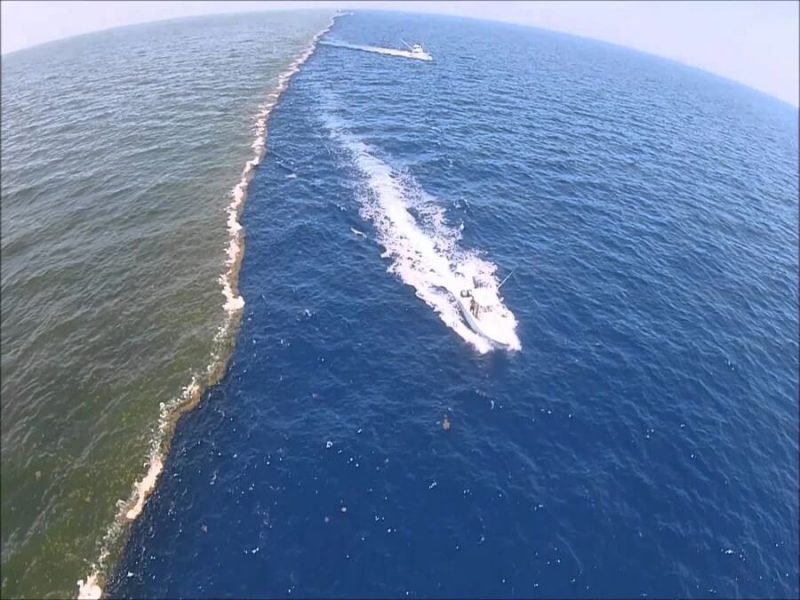
Unmixed seas found
Summary: In this article, we answer the questions of whether there are unmixed seas and how this is possible. First, we talk about the halocline and thermocline barrier, using undersea currents and under-ocean waves as examples. We gave a small lake called Cenuta angelita as an example to better understand the halocline barrier. Then we mentioned the halocline barriers that form between large sea masses. We showed the huge sea masses in the Gulf of Alaska and in the Baltic Sea as examples of this. We continued with the halocline barrier in the Arctic Ocean as an example of the non-mixing of fresh and salt water, and then we talked about the freshwater lake discovered under the Atlantic Ocean and the freshwater lakes in the Baltic Sea. We then showed how the opponents of the Qur’an, in particular, have tried to conceal the miraculousness of this verse with word and rhetorical games.
Unmixed seas
Question: Where are the unmixed seas? The Qur’an says that there are unmixed seas. Moreover, in one of these verses, it is stated that fresh and salt water seas do not mix. But some say that seas mix with each other due to their nature
Let us look at the verses that talk about the phenomenon of the unmixed seas;
Surah Ar-Rahman 19-20: “There is a barrier between them; they do not cross each other’s boundary.”
Surah Al-Furqan 53: “It is He who released the two seas. One is sweet and thirst-quenching and the other is salty and bitter. Yet He has placed between them a barrier and an impassable boundary.”
“The original meaning of the Arabic word “Bahr” refers to a place that gathers a large body of water. This is the basic meaning of the word.”
The Arabic word “Bahr” refers to all large bodies of water such as oceans, seas, lakes and large rivers.
Ocean currents are examples of unmixed sea water
Within the oceans, there are large currents that, although their salt content and temperature levels are different from those of the ocean through which they flow, are delivered to their destinations in much the same way as a vein delivers blood to nourish tissue. For example, one of the largest of these is the Gulf Stream warm water current, which starts in the Gulf of Mexico and carries warm water all the way to the north of Greenland, where it tempers the climate and makes the north more habitable.
“After starting its journey in the Gulf of Mexico, it follows the east coast of North America, moving to the coast of Florida and then to Newfoundland. The current then crosses the Atlantic Ocean and splits into two; one arm reaches the west coast of Europe, while the other moves towards the coast of West Africa. The warmth of the current flowing off the continental shelf forms the structure called the ‘Cold Wall’ together with the cold southern current flowing off the coast of the continent. Here the deep blue waters of the current can be easily distinguished from other waters.” https://tr.wikipedia.org/wiki/Gulf_Stream
Thermocline and Halocline barriers and the phenomenon of unmixed seas
As seen above, even science describes this situation as in the Qur’anic terms and calls what the Qur’an describes as the Barrier as the “Cold Wall”. In the literature, this wall that forms the phenomenon of the unmixed seas is called Thermocline and Halocline barriers. It is also called surface tension.
The Qur’an reports this phenomenon and scientists, like the Qur’an, call this structure a wall and say that it functions to ensure the phenomena of unmixed waters. For example, let’s see how Richard A. Davis, an oceanographer, describes it in his book:
“The surface tension caused by the different densities of the seas prevents their waters from mixing like a wall. (Richard A. Davis, Principles of Oceanography, Addison-Wesley Publishing Company, Don Mills, Ontario, pp. 92-93)”
The main reason for this wall formation, which gives rise to the phenomenon of unmixed seas, is differences in salinity and temperature. Rivers with a salt content higher than the ocean’s salt level flow under the ocean, while waters with low salt content flow from above. Similar to the vena (veins) and arteries (arteries) in the human body, these waters take warm water from the south to the north and then return and transfer cold water from the north to the south. This phenomenon, which regulates the Earth’s climate, is called “thermohaline circulation”, with the word “thermo” referring to the temperature difference of the currents and “haline” referring to the salinity difference. The reality of two unmixed seas is created by these mechanisms.

The reality of the cold wall and the huge sea currents is just one of many examples of unmixed sea waters. You will see others soon. The mechanism of all of them is based on thermocline and halocline barriers. Again, in the glacial seas, there are unmixed fresh water and salt water masses.
The Gulf Stream warm water flow contributes to the melting of the Greenland glaciers. The fresh water that melts here stays above because it is less dense, and the cold salt water that flows to the south sinks due to its density and stays below. This phenomenon is called the Halocline barrier, which means the formation of a barrier between fresh and salt water. Again, if the waters have temperature differences, another barrier is formed, which is called Thermocline barrier. These barriers are shown in the two pictures below.
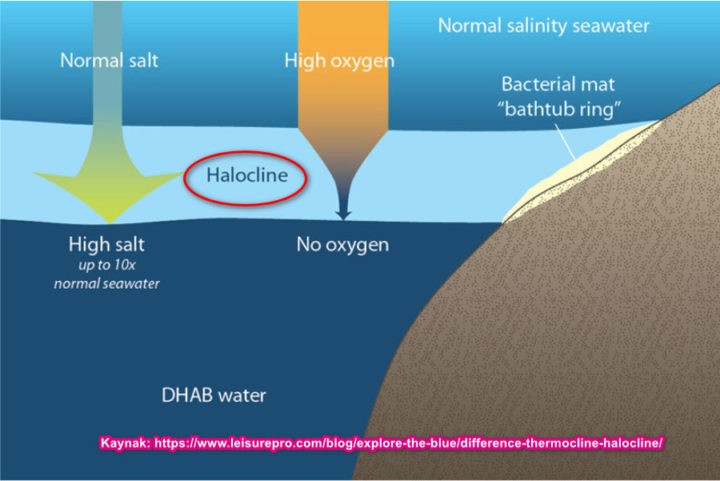
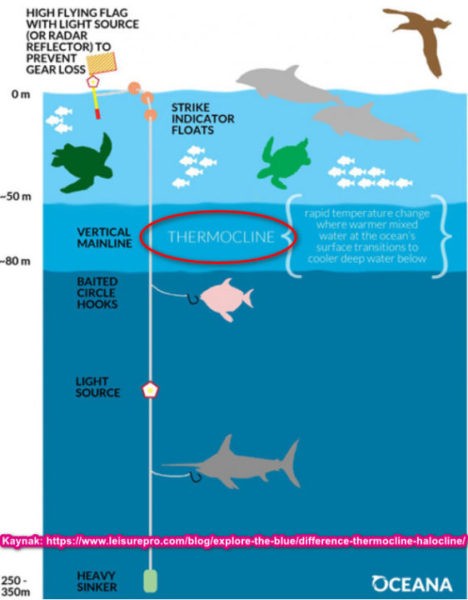
Fresh water and salt water that cannot converge
Now I will give you the information you can find in an article published in Nature, which is an example of the unmixed seas. Moreover, the second verse above refers to unmixed fresh and salt waters.
The Gulf Stream warm water current that reaches the Arctic Ocean also contributes to the melting of glaciers. The melting glaciers become fresh water and form a halocline barrier, separating it from the sea of salt water below. Because of the halocline barrier, in glacial areas in the Arctic ice sea, you can access fresh water in the upper part of the sea and salt water below 50 meters. Water that mixes immediately by nature cannot mix because of an invisible halocline barrier. This is how the unmixed sea waters (fresh and salt water) is clearly visible in the Arctic sea.
The sea of fresh water and the sea of salt water mentioned in verse 53 of Surat al-Furqan do not have to be horizontally adjacent to each other, but can also refer to huge sized bodies of water, one above and one below. In Arabic, the word bahr is used to refer to oceans, seas, lakes and large rivers. So it is a word used to describe large bodies of water.

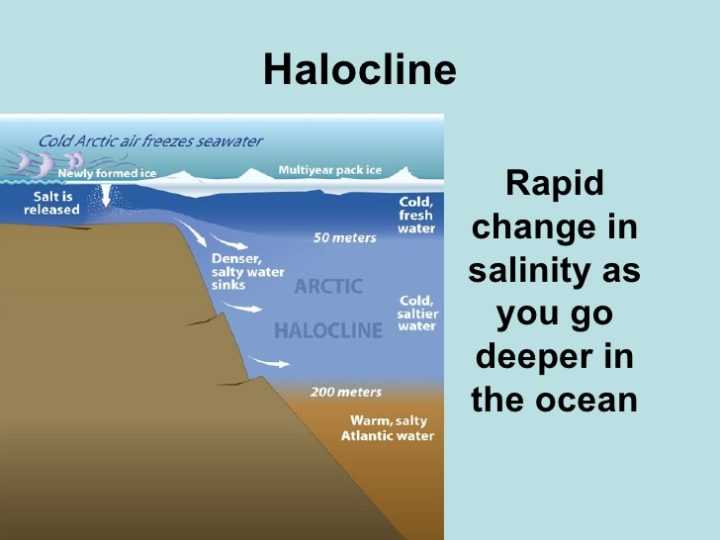
Fresh and salty unmixed seas under the ocean
The phenomenon of freshwater and saltwater not mixing in the seas is not limited to this. After I wrote this article, a bigger phenomenon was discovered. The world’s largest freshwater basin has been found under the Atlantic Ocean.
Scientists have discovered a huge freshwater basin under the salty waters of the Atlantic Ocean. According to measurements, the underground basin has the volume of 1.1 billion Olympic pools. This freshwater sea was formed at the end of the ice age and trapped under salt water. They are separated from each other by sharp boundaries and do not mix.
Researchers were astonished to find fresh water in a basin off the coast of the northeastern United States, which was discovered when they went deep enough.
The 2,800 cubic kilometer basin under the ocean floor from New Jersey to Massachusetts is the largest known freshwater basin in the world. It is now being investigated whether there are other similar freshwater basins.
For detailed info: https://edition.cnn.com/2019/06/26/us/freshwater-aquifer-hidden-trnd/index.html
Also in the Baltic Sea, in the Gulf of Gdansk, there are fresh lakes in a salty sea. A screenshot from a scientific paper describing this is given below.

The river flowing independently in the Black Sea
Also in the Black Sea, a large and salty undersea river was discovered by researchers in 2010. This is an example of a thermocline and halocline barrier. https://en.wikipedia.org/wiki/Black_Sea_undersea_river This is a current in the sea with trees and a waterfall.
Below is a 3-D radar image:

Cenota Angelita, an example of a halocline barrier in nature
An underground cave river in the jungle in Mexico, called Cenota Angelita, was found to contain fresh water at the top and salt water at the bottom. The reason why fresh and salt water do not mix here was explained by the explorer with a halocline barrier. Reference link



The picture shows the second puddle of salt water below the swimmer, which does not mix with the fresh water above. This picture is included because it is remarkable to show that such situations exist in nature.
Unmixed lake under the Atlantic Ocean
As an example of a unmixed seas, there is a lake called Brine Pool under the Atlantic Ocean, whose water is saltier than the ocean above it and separated by sharp borders. Their living creatures are different. If they cross this boundary, they suffer toxic shock. See the short BBC video below. This example also demonstrates the reality of two unmixed seas.
The fact of this halocline barrier, which shows two unmixed seas, is well known to oceanographers. For example, at the meeting point of the BALTIC SEA and the NORTH SEA in Denmark, the large bodies of water do not mix immediately due to the difference in density and temperature. They look like two seas with a barrier (halocline barrier) between them. You can see this image there all the time. You can see the same image in the Gulf of Alaska. Two places where the fact of two unmixed seas can be seen very concretely in the seas are the Baltic Sea and the Gulf of Alaska.
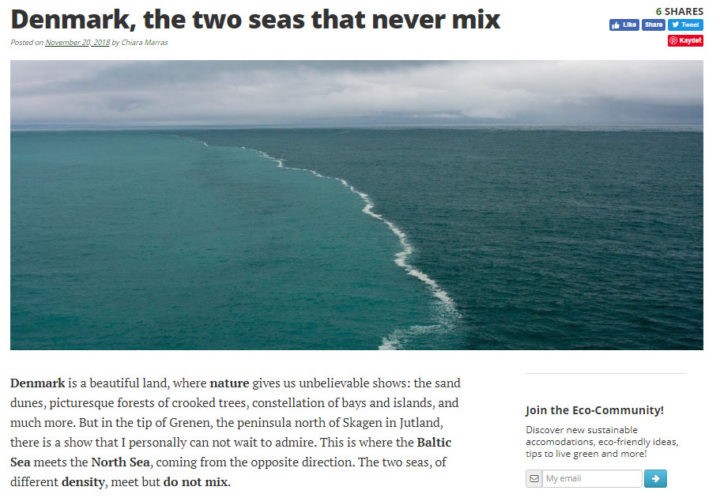
The different densities of the seas are thought to be related to melting glacial waters. The continuation of this halocline barrier in the unmixed seas depends on the continuation of glacial waters. In other words, if there is a continuous mixing of glacial water, when you go to that region, you can see two seas of different colors and chemistry separated by a barrier. If the flow of glacial water stops, this barrier also disappears after a while. So at least one of the waters meeting in the seas has to be DYNAMIC, and the verse has already told us that when the two seas release to meet, a barrier is formed between them. So according to the verse, there has to be a dynamic encounter, that is, there has to be a flow.
Sub-ocean waves
Sea samples that do not mix with each other are formed by halocline and thermocline barriers. Another example of a halocline barrier; WAVES UNDER OCEANS are formed by this halocline barrier. Waters that do not mix fluctuate within each other but eventually mix. This later mixing does not change the fact that they dance without mixing with each other.
But don’t the seas have to mix, even if it’s late?
We have shown in this article that there are areas in the seas where the waters do not mix with each other due to differences in salinity and temperature, forming seas that do not mix with each other. We said that if such different bodies of water meet, a CURTAIN that prevents mixing between them is formed, which science calls the HALOCLIN BARRIER. Although this is a clear miracle of the Qur’an, atheists are trying to cover up this miracle by saying “it is impossible for the waters not to mix on Earth, they mix, even if slowly” to dilute this miracle. This claim was taught to atheists for the first time by an ideological atheist site masquerading as scientific, and since atheists have no other branch to cling to, they do not want to let go of this idea even if you refute it, and they are so brazen as to present a clear miracle as a scientific contradiction.
Their misconception here is that scientists do not claim that the HALOCLIN BARRIER that forms where the waters meet goes on and on and surrounds the Earth so that these waters cannot find a hole anywhere to mix with each other. But atheists twist statements that even scientists make in the same wording as the Qur’an in order to dilute this amazing scientific fact that science calls the halocline barrier. Of course the halocline barrier does not extend infinitely, if you follow the halocline barrier on a line it weakens at some point and then disappears.
So the sea waters that do not mix mix mix at distant points where the halocline barrier disappears. But when you go back and come back to where the halocline barrier is, you will see that the halocline barrier is still there and that there has been a halocline barrier in that area for years, maybe centuries, and that the waters with different chemical structures and temperatures do not mix at THESE POINTS. I repeat once again to my atheist friends who do not want to understand this, the seas do not mix at points where there is a halocline barrier, but at points kilometers ahead there is no halocline barrier. The fact that these waters mix where there is no halocline barrier does not change the fact of HALOCLIN BARRIER.
Thanks to this halocline wall, you can stand at the same spot and take a different water sample from your right, a different water sample from your left or, at the poles, a salt water sample from below you and a fresh water sample from above you without ever leaving your place. The fact that the sea does not mix with each other shows that halocline and thermocline barriers were miraculously known to the Quran.
The logic games of non-theists are endless
I will give you an example so that you can understand the logic game they set up to deny the reality of the unmixed sea with the fallacy of logic. For example, you say that the soldiers of the Turkish nation are made up of 20-year-olds, that’s how the army stays young. The non-theist plays a logic game and says that people have to grow old, so this is not true. This logic game makes sense to you too. People have to grow old. But what they are hiding is that old soldiers are leaving and new 20-year-old soldiers are constantly joining the army.
In the same way, the old waters of the seas that do not mix with each other migrate to different points and sooner or later mix with each other, true, but there is always a curtain in that region between the new waters, and that is why you can always see the miracle of the seas separating from each other with your eyes. So in the first example, it is not the people who stay young, but the army of people. In the second example, it is not the waters that do not mix, but the seas formed by the waters. I hope this is clear.
Ancient people also knew that the seas did not mix, in their defense.
I hope it is clear now that their above claims are illustrated with an example. As support for their claim, they claim that this unmixed sea incident was written by the Roman Gaius Plinius Secundus in 50 AD, and that our Prophet could have taken it from this. We will say the following about their claim. Let us first look at the words of Gaius:
“The properties of the fresh water that flows into the sea as if through a pipe are even more interesting and wonderful. Because there are astonishing properties in water. The sea water, which is heavier, carries the fresh water, which is lighter than it. Therefore, since fresh water is lighter than sea water, it does not mix with sea water and floats on the sea.” (Gaius Plinius Secundus, Naturalis Historiae II, CVI 224)
As you will notice in the article, he says that the water flowing into the sea like a pipe does not mix, that is, he means the point where the rivers flow into the sea and says that it does not mix. He observed this and wrote about it. Yes, rivers form a layer of fresh water due to the halocline barrier formed at the point where they first mix with the sea. But what is mentioned in the verse is fresh water and salt water sea. So it is not the mixing of river and sea. Even Gaius could not have predicted the immiscibility of large seas like the Alaskan sea, he only saw and reported that river and sea water did not mix on the surface.
To claim that the Qur’an got the phenomenon of unmixed seas from Gaius or Aristotle is absurd for a society that does not know much about literature, does not have libraries, does not have the internet. Especially claiming that he did not take any of their mistakes, but only the right ones, constitutes the second act of logical fallacy. Ninety percent of what these ancient philosophers said in scientific terms is known to be wrong today. But there is no scientific contradiction in the Qur’an. We have thoroughly explained with scientific evidence at www.bilimveyaratilisagaci.com that the verses claimed to be contradictory are not contradictions but scientific miracles. Why is the Qur’an not full of misinformation of ancient scholars or societies, why is there not a single verse that they can clearly call a contradiction, but they try to falsify the verses by twisting them? I leave the answer to everyone’s conscience.
The fact that the two unmixed seas shows that the halocline and thermocline barriers are miraculously known to the Quran.
Where are the unmixed seas?
Do unmixed seas only exist on the surface?
Is it a scientific fact that the seas do not mix?
Bu yazı hakkında ne düşünüyorsunuz?

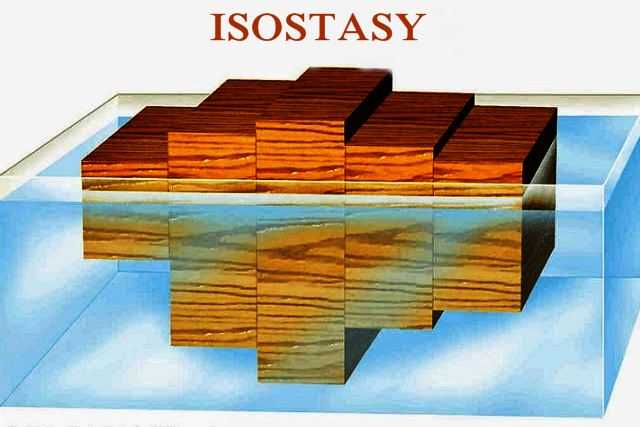
Hocam ilk defa İngilizce yazımızı gördüm, çok güzel olmuş, yabancılarıda bilgilendirmiş oluyorsunuz hemde, elinize sağlık.
Bu yazı hakkında ne düşünüyorsunuz?